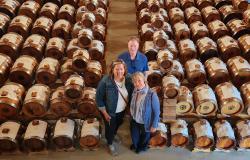 (ANSA) - British architect Sir Norman Foster has been given the job of remodelling the historic sea
(ANSA) - British architect Sir Norman Foster has been given the job of remodelling the historic sea
front area of this northern Italian city.
The project is part of Trieste's ongoing efforts to recover the splendour it enjoyed when it was one of the treasures of the Hapsburg Empire. The city commissioned Foster's studio - Foster and Partners - to prepare the renovation masterplan for its vast Porto Vecchio (old port). The aim is to put it among the world's most charming, evocative historic harbours.
The 600,000-square-metre area has huge potential, with several buildings dating back to the city's imperial glory days, but is in major need of a spruce-up. Trieste, which is perched on the north Adriatic coast on the border with Slovenia, was a cosmopolitan and tolerant haven of prosperity during much of its five centuries in the Hapsburg Empire.
However, when the city was annexed to the rest of Italy at the end of World War I, it went from being the Austro-Hungarian Empire's only seaport to being one of many in the Bel Paese. Trieste's new governors had little economic use for it, the city lost business and much of its cosmopolitan identity, and an aura of decline set in for most of the 20th century.
In the last few years though, it has picked itself up, brushed itself down and started to take advantage of its strategic position as a 'gateway to the East' to re-emerge as a centre of tourism and commerce.
A huge urban renovation project has helped give Trieste its brio back, and the city made a strong - although ultimately unsuccessful - bid to host the 2007 Universal Expo.
By asking Foster, one of the world's top contemporary architects, to transform its old port, the city is clearly seeking to stay on the upward curve. In 1999 Foster won his profession's most prestigious award, the Pritzker Architecture Prize. He has also collected an array of other top accolades. These include the Praemium Imperiale Award for Architecture (2002), the American Institute of Architects Gold Medal for Architecture (1994) and the Gold Medal of the French Academy of Architecture (1991).
His studio is behind highly acclaimed projects, like the new German Parliament in Berlin, Beijing International Airport and the headquarters for HSBC bank in Hong Kong and London.
Trieste was originally founded in the second century BC by the Romans, who called it Tergeste: terg -'market', este - 'city'. During World War II it was annexed by the Germans and at the end of the war the city and the surrounding area was disputed between Yugoslavia and the Allies, who wanted it to remain Italian to prevent it falling into communist hands. Only in 1954 was the city's status as part of Italy finally sanctioned by an international agreement. But Trieste's difficult history is now part of its
appeal. The city is ethnically mixed - it has a large Slovenian-speaking minority - and the rich local cuisine is spiced with Slav, German, Hungarian and Italian influences. Set into a limestone plateau overlooking the blue Adriatic Sea, the city offers visitors a number of places of cultural and scientific interest, such as the History and Art and Revoltella museums and San Giusto Cathedral.
